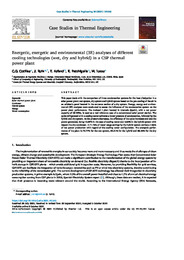Por favor, use este identificador para citar o enlazar este ítem:
https://hdl.handle.net/11000/35364Registro completo de metadatos
| Campo DC | Valor | Lengua/Idioma |
|---|---|---|
| dc.contributor.author | García Cutillas, Clemente | - |
| dc.contributor.author | Ruiz Ramírez, Javier | - |
| dc.contributor.author | Asfand, Faisal | - |
| dc.contributor.author | patchigolla, kumar | - |
| dc.contributor.author | Lucas Miralles, Manuel | - |
| dc.contributor.other | Departamentos de la UMH::Ingeniería Mecánica y Energía | es_ES |
| dc.date.accessioned | 2025-01-28T09:10:29Z | - |
| dc.date.available | 2025-01-28T09:10:29Z | - |
| dc.date.created | 2021 | - |
| dc.identifier.citation | Case Studies in Thermal Engineering | es_ES |
| dc.identifier.issn | 2214-157X | - |
| dc.identifier.uri | https://hdl.handle.net/11000/35364 | - |
| dc.description.abstract | This paper deals with the comparison of three condensation systems for the heat dissipation in a solar power plant: wet system, dry system and hybrid system based on the pre-cooling of the air in an adiabatic panel located in the entrance section of a dry system. Energy, exergy and environmental (3E) analyses were conducted to assess the influence of the condensation system on the power plant performance. The Andasol I plant located in Granada (Spain), with a net power capacity of 50 MWe, is used as a real reference case of a concentrated solar power station. The cycle refrigerated with a cooling tower achieves a lower pressure of condensation, followed by the hybrid and dry system. As the pressure decreases, the efficiency of the cycle increases and also the power generated, being 12.60% in the case of cooling tower and 4.65% in the hybrid system with respect the dry condenser. A 71.74% of water usage savings by the hybrid system carries a 7.06% of net power production with regard of the cooling tower configuration. The exergetic performance of the plant is 73.77% for the wet system, 69.21% for the hybrid and 68.46% for the dry system. | es_ES |
| dc.format | application/pdf | es_ES |
| dc.format.extent | 18 | es_ES |
| dc.language.iso | eng | es_ES |
| dc.publisher | Elsevier | es_ES |
| dc.relation.ispartofseries | 28 | es_ES |
| dc.rights | info:eu-repo/semantics/openAccess | es_ES |
| dc.rights.uri | http://creativecommons.org/licenses/by-nc-nd/4.0/ | * |
| dc.subject | Solar thermal power plant | es_ES |
| dc.subject | Condenser | es_ES |
| dc.subject | Hybrid system | es_ES |
| dc.subject | Exergy | es_ES |
| dc.subject | Water consumption | es_ES |
| dc.subject.other | CDU::6 - Ciencias aplicadas::62 - Ingeniería. Tecnología::621 - Ingeniería mecánica en general. Tecnología nuclear. Electrotecnia. Maquinaria | es_ES |
| dc.title | Energetic, exergetic and environmental (3E) analyses of different cooling technologies (wet, dry and hybrid) in a CSP thermal power plant | es_ES |
| dc.type | info:eu-repo/semantics/article | es_ES |
| dc.relation.publisherversion | https://doi.org/10.1016/j.csite.2021.101545 | es_ES |

Ver/Abrir:
2021 CSTE.pdf
2,77 MB
Adobe PDF
Compartir:
 La licencia se describe como: Atribución-NonComercial-NoDerivada 4.0 Internacional.
La licencia se describe como: Atribución-NonComercial-NoDerivada 4.0 Internacional.
.png)